2016 NISSAN NOTE ECU
[x] Cancel search: ECUPage 2154 of 3641
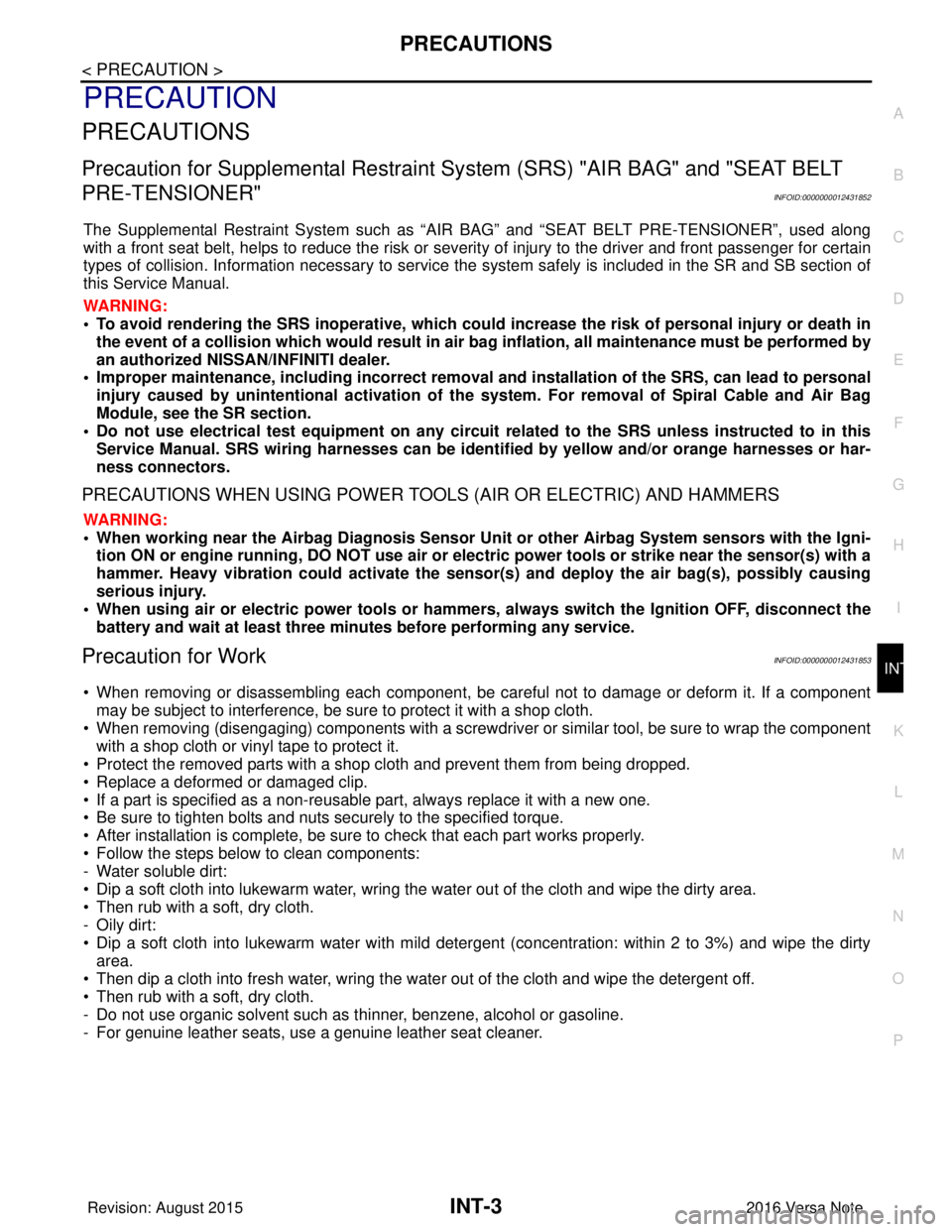
PRECAUTIONSINT-3
< PRECAUTION >
C
DE
F
G H
I
K L
M A
B
INT
N
O P
PRECAUTION
PRECAUTIONS
Precaution for Supplemental Restraint System (SRS) "AIR BAG" and "SEAT BELT
PRE-TENSIONER"
INFOID:0000000012431852
The Supplemental Restraint System such as “AIR BAG” and “SEAT BELT PRE-TENSIONER”, used along
with a front seat belt, helps to reduce the risk or severi ty of injury to the driver and front passenger for certain
types of collision. Information necessary to service the system safely is included in the SR and SB section of
this Service Manual.
WARNING:
• To avoid rendering the SRS inoper ative, which could increase the risk of personal injury or death in
the event of a collision which would result in air bag inflation, all maintenance must be performed by
an authorized NISSAN/INFINITI dealer.
• Improper maintenance, including in correct removal and installation of the SRS, can lead to personal
injury caused by unintentional act ivation of the system. For removal of Spiral Cable and Air Bag
Module, see the SR section.
• Do not use electrical test equipm ent on any circuit related to the SRS unless instructed to in this
Service Manual. SRS wiring harnesses can be identi fied by yellow and/or orange harnesses or har-
ness connectors.
PRECAUTIONS WHEN USING POWER TOOLS (AIR OR ELECTRIC) AND HAMMERS
WARNING:
• When working near the Airbag Diagnosis Sensor Un it or other Airbag System sensors with the Igni-
tion ON or engine running, DO NOT use air or el ectric power tools or strike near the sensor(s) with a
hammer. Heavy vibration could activate the sensor( s) and deploy the air bag(s), possibly causing
serious injury.
• When using air or electric power tools or hammers, always switch the Ignition OFF, disconnect the
battery and wait at least three mi nutes before performing any service.
Precaution for WorkINFOID:0000000012431853
• When removing or disassembling each component, be ca reful not to damage or deform it. If a component
may be subject to interference, be sure to protect it with a shop cloth.
• When removing (disengaging) components with a screwdriver or similar tool, be sure to wrap the component with a shop cloth or vinyl tape to protect it.
• Protect the removed parts with a shop cloth and prevent them from being dropped.
• Replace a deformed or damaged clip.
• If a part is specified as a non-reusabl e part, always replace it with a new one.
• Be sure to tighten bolts and nuts securely to the specified torque.
• After installation is complete, be sure to check that each part works properly.
• Follow the steps below to clean components:
- Water soluble dirt:
• Dip a soft cloth into lukewarm water, wring the water out of the cloth and wipe the dirty area.
• Then rub with a soft, dry cloth.
-Oily dirt:
• Dip a soft cloth into lukewarm water with mild detergent (concentration: within 2 to 3%) and wipe the dirty
area.
• Then dip a cloth into fresh water, wring the water out of the cloth and wipe the detergent off.
• Then rub with a soft, dry cloth.
- Do not use organic solvent such as thinner, benzene, alcohol or gasoline.
- For genuine leather seats, use a genuine leather seat cleaner.
Revision: August 2015 2016 Versa Note
cardiagn.com
Page 2161 of 3641
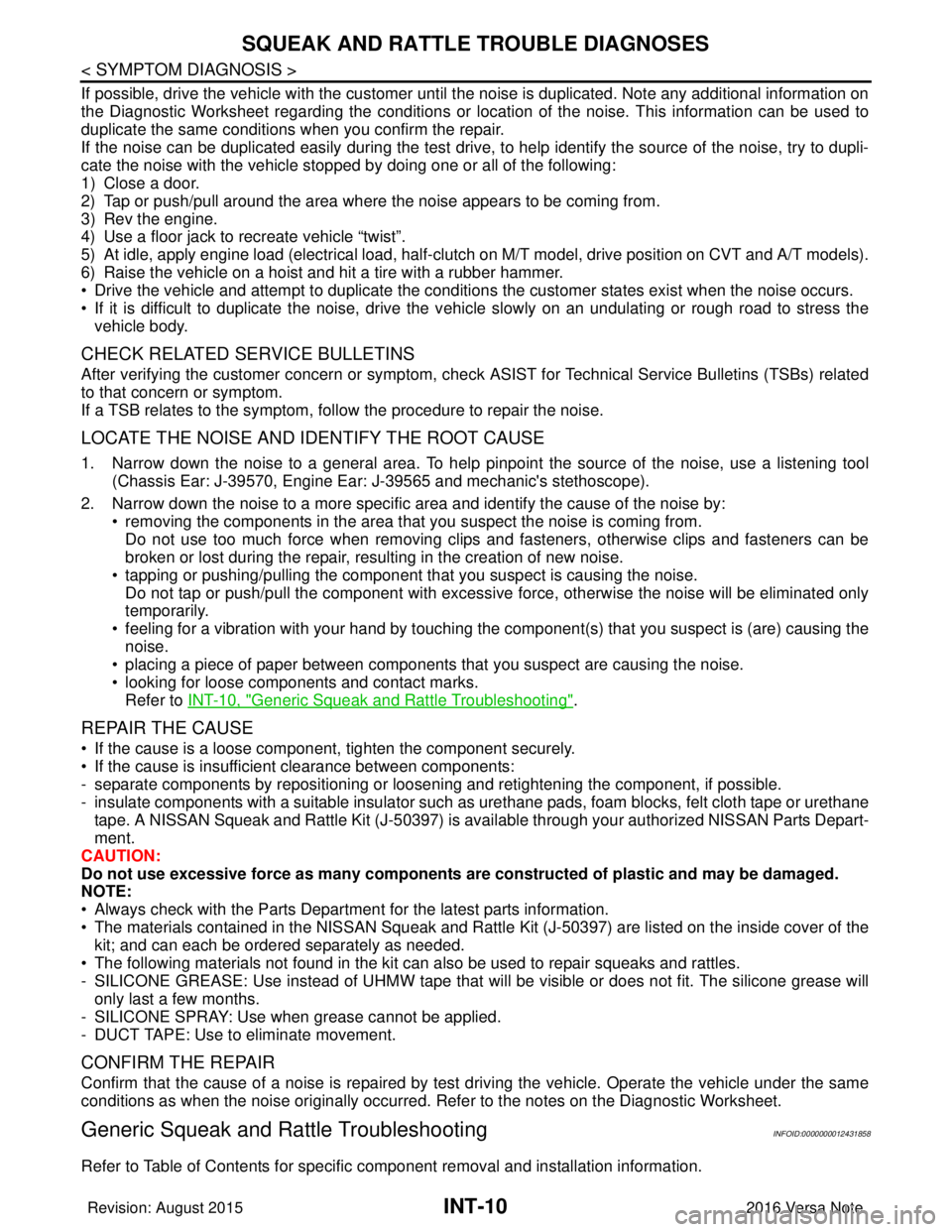
INT-10
< SYMPTOM DIAGNOSIS >
SQUEAK AND RATTLE TROUBLE DIAGNOSES
If possible, drive the vehicle with the customer until the noise is duplicated. Note any additional information on
the Diagnostic Worksheet regarding the conditions or lo cation of the noise. This information can be used to
duplicate the same conditions when you confirm the repair.
If the noise can be duplicated easily during the test drive, to help identify the source of the noise, try to dupli-
cate the noise with the vehicle stopped by doing one or all of the following:
1) Close a door.
2) Tap or push/pull around the area where the noise appears to be coming from.
3) Rev the engine.
4) Use a floor jack to recreate vehicle “twist”.
5) At idle, apply engine load (electrical load, half-clutch on M/T model, drive position on CVT and A/T models).
6) Raise the vehicle on a hoist and hit a tire with a rubber hammer.
• Drive the vehicle and attempt to duplicate the conditions the customer states exist when the noise occurs.
• If it is difficult to duplicate the noise, drive the v ehicle slowly on an undulating or rough road to stress the
vehicle body.
CHECK RELATED SERVICE BULLETINS
After verifying the customer concern or symptom, chec k ASIST for Technical Service Bulletins (TSBs) related
to that concern or symptom.
If a TSB relates to the symptom, follo w the procedure to repair the noise.
LOCATE THE NOISE AND IDENTIFY THE ROOT CAUSE
1. Narrow down the noise to a general area. To help pi npoint the source of the noise, use a listening tool
(Chassis Ear: J-39570, Engine Ear: J-39565 and mechanic's stethoscope).
2. Narrow down the noise to a more specific area and identify the cause of the noise by: • removing the components in the area that you suspect the noise is coming from.Do not use too much force when removing clips and fasteners, otherwise clips and fasteners can be
broken or lost during the repair, resulting in the creation of new noise.
• tapping or pushing/pulling the component that you suspect is causing the noise. Do not tap or push/pull the component with excessive force, otherwise the noise will be eliminated only
temporarily.
• feeling for a vibration with your hand by touching the component(s) that you suspec t is (are) causing the
noise.
• placing a piece of paper between components that you suspect are causing the noise.
• looking for loose components and contact marks.
Refer to INT-10, "
Generic Squeak and Rattle Troubleshooting".
REPAIR THE CAUSE
• If the cause is a loose component, tighten the component securely.
• If the cause is insufficient clearance between components:
- separate components by repositioning or loos ening and retightening the component, if possible.
- insulate components with a suitable insulator such as urethane pads, foam blocks, felt cloth tape or urethane tape. A NISSAN Squeak and Rattle Kit (J-50397) is av ailable through your authorized NISSAN Parts Depart-
ment.
CAUTION:
Do not use excessive force as many components are constructed of plastic and may be damaged.
NOTE:
• Always check with the Parts Department for the latest parts information.
• The materials contained in the NISSAN Squeak and Rattle Kit (J-50397) are listed on the inside cover of the
kit; and can each be ordered separately as needed.
• The following materials not found in the kit can also be used to repair squeaks and rattles.
- SILICONE GREASE: Use instead of UHMW tape that will be visible or does not fit. The silicone grease will only last a few months.
- SILICONE SPRAY: Use when grease cannot be applied.
- DUCT TAPE: Use to eliminate movement.
CONFIRM THE REPAIR
Confirm that the cause of a noise is repaired by test driving the vehicle. Operate the vehicle under the same
conditions as when the noise originally occurred. Refer to the notes on the Diagnostic Worksheet.
Generic Squeak and Rattle TroubleshootingINFOID:0000000012431858
Refer to Table of Contents for specific component removal and installation information.
Revision: August 2015 2016 Versa Note
cardiagn.com
Page 2163 of 3641

INT-12
< SYMPTOM DIAGNOSIS >
SQUEAK AND RATTLE TROUBLE DIAGNOSES
1. Loose harness or harness connectors.
2. Front console map/reading lamp lens loose.
3. Loose screws at console attachment points.
SEATS
When isolating seat noise it's important to note the position the seat is in and the load placed on the seat when
the noise is present. These conditions should be duplicated when verifying and isolating the cause of the
noise.
Cause of seat noise include:
1. Headrest rods and holder
2. A squeak between the seat pad cushion and frame
3. The rear seatback lock and bracket
These noises can be isolated by moving or pressing on the suspected components while duplicating the con-
ditions under which the noise occurs. Most of thes e incidents can be repaired by repositioning the component
or applying urethane tape to the contact area.
UNDERHOOD
Some interior noise may be caused by components under the hood or on the engine wall. The noise is then
transmitted into the passenger compartment.
Causes of transmitted underhood noise include:
1. Any component installed to the engine wall
2. Components that pass through the engine wall
3. Engine wall mounts and connectors
4. Loose radiator installation pins
5. Hood bumpers out of adjustment
6. Hood striker out of adjustment
These noises can be difficult to isolate since they cannot be reached from the interior of the vehicle. The best
method is to secure, move or insulate one component at a time and test drive the vehicle. Also, engine rpm or
load can be changed to isolate the noise. Repairs can usually be made by moving, adjusting, securing, or
insulating the component causing the noise.
Revision: August 2015 2016 Versa Note
cardiagn.com
Page 2167 of 3641
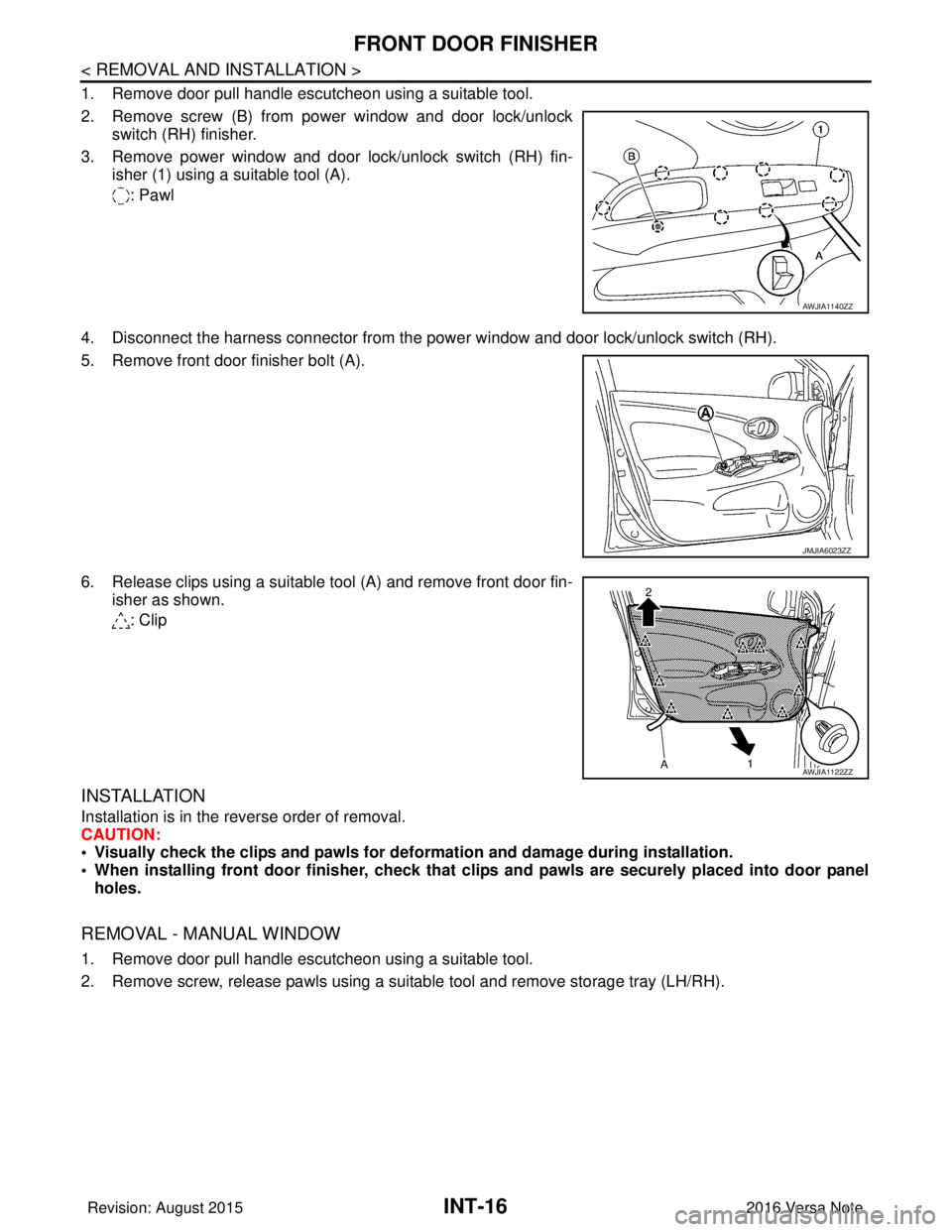
INT-16
< REMOVAL AND INSTALLATION >
FRONT DOOR FINISHER
1. Remove door pull handle escutcheon using a suitable tool.
2. Remove screw (B) from power window and door lock/unlockswitch (RH) finisher.
3. Remove power window and door lock/unlock switch (RH) fin- isher (1) using a suitable tool (A).
: Pawl
4. Disconnect the harness connector from the pow er window and door lock/unlock switch (RH).
5. Remove front door finisher bolt (A).
6. Release clips using a suitable tool (A) and remove front door fin- isher as shown.
: Clip
INSTALLATION
Installation is in the reverse order of removal.
CAUTION:
• Visually check the clips and pawls for deformation and damage during installation.
• When installing front door finisher, check that cl ips and pawls are securely placed into door panel
holes.
REMOVAL - MANUAL WINDOW
1. Remove door pull handle escutcheon using a suitable tool.
2. Remove screw, release pawls using a suitable tool and remove storage tray (LH/RH).
AWJIA1140ZZ
JMJIA6023ZZ
AWJIA1122ZZ
Revision: August 2015 2016 Versa Note
cardiagn.com
Page 2168 of 3641
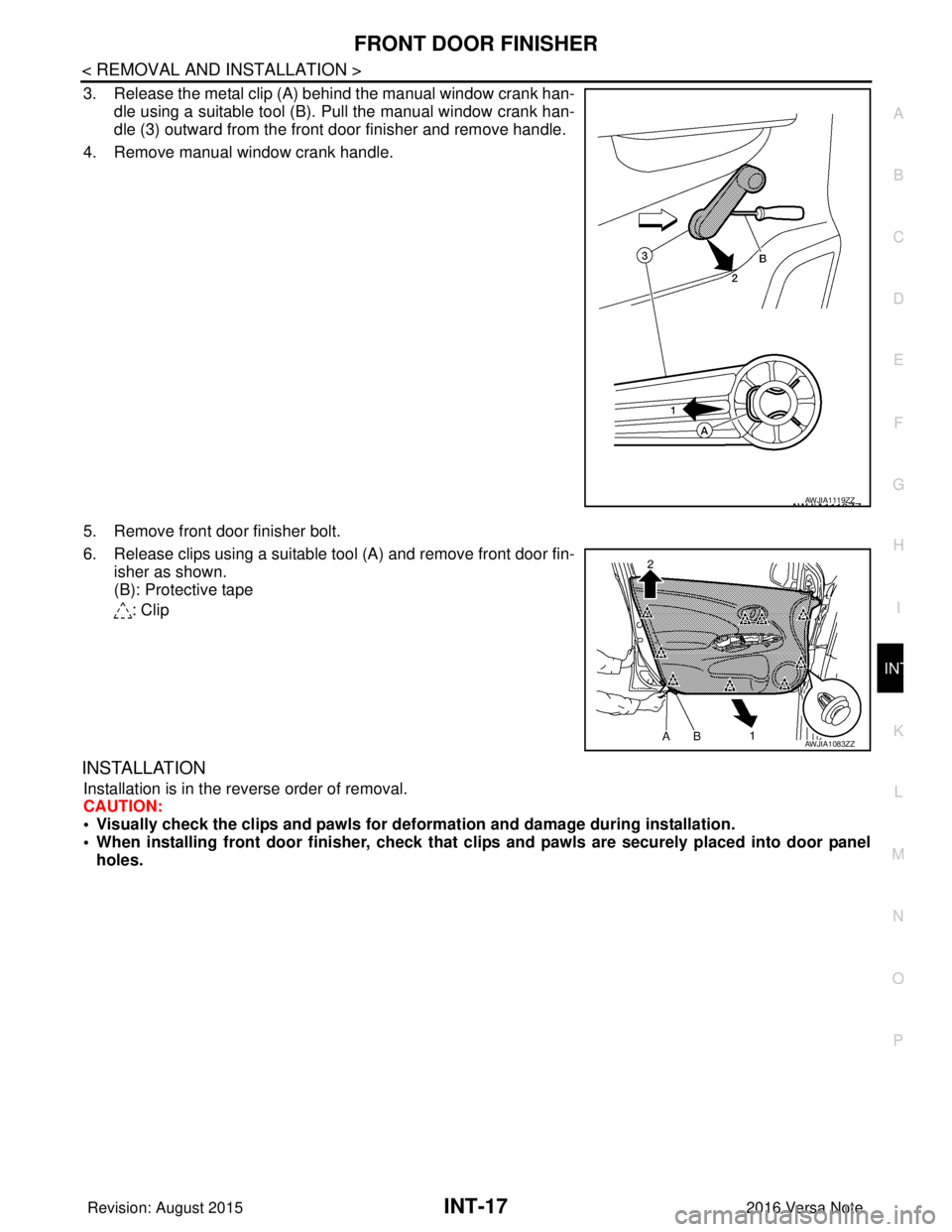
FRONT DOOR FINISHERINT-17
< REMOVAL AND INSTALLATION >
C
DE
F
G H
I
K L
M A
B
INT
N
O P
3. Release the metal clip (A) behind the manual window crank han- dle using a suitable tool (B). Pull the manual window crank han-
dle (3) outward from the front door finisher and remove handle.
4. Remove manual window crank handle.
5. Remove front door finisher bolt.
6. Release clips using a suitable tool (A) and remove front door fin- isher as shown.
(B): Protective tape
: Clip
INSTALLATION
Installation is in the reverse order of removal.
CAUTION:
• Visually check the clips and pawls for defo rmation and damage during installation.
• When installing front door finisher, check that clips and pawls are securely placed into door panel
holes.
AWJIA1119ZZ
AWJIA1083ZZ
Revision: August 2015 2016 Versa Note
cardiagn.com
Page 2170 of 3641
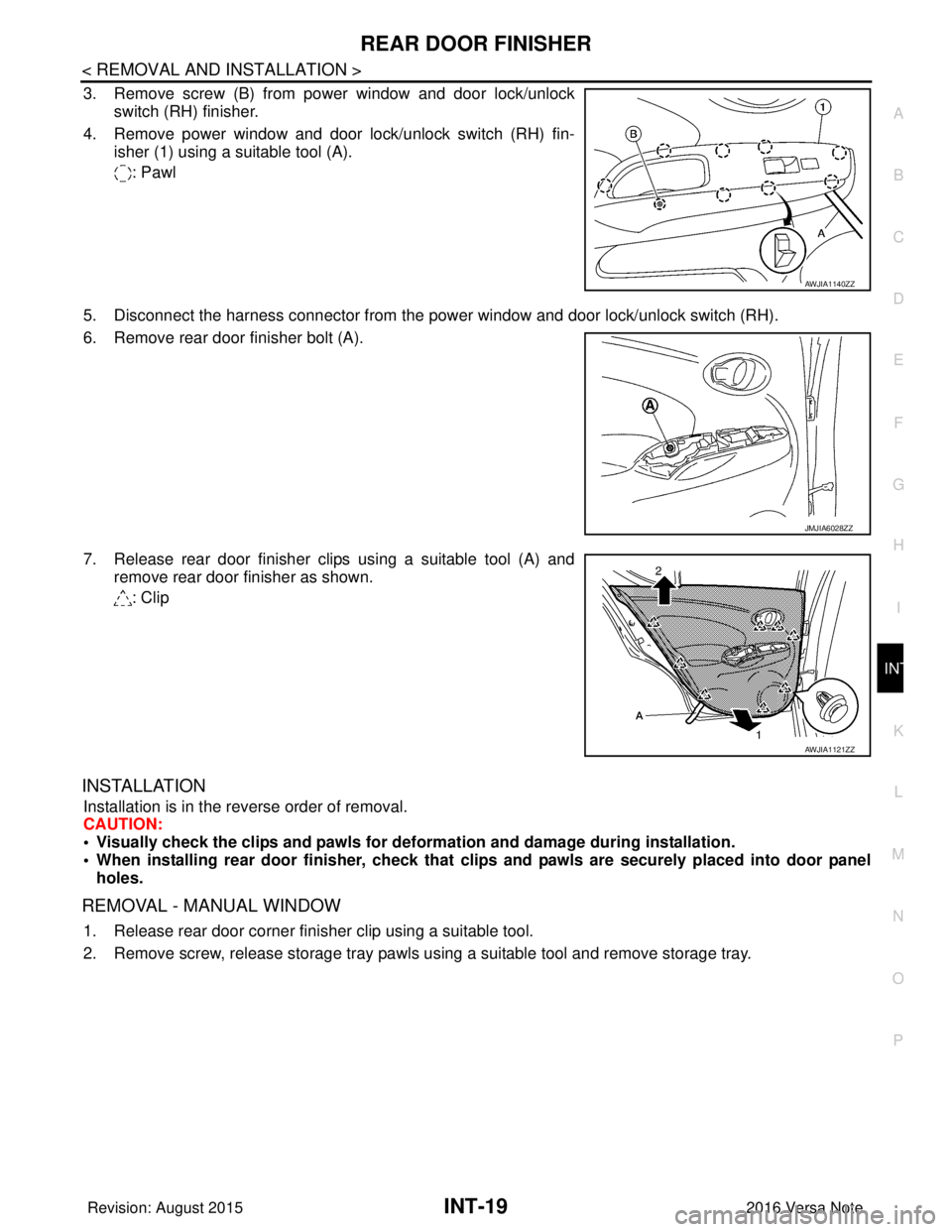
REAR DOOR FINISHERINT-19
< REMOVAL AND INSTALLATION >
C
DE
F
G H
I
K L
M A
B
INT
N
O P
3. Remove screw (B) from power window and door lock/unlock switch (RH) finisher.
4. Remove power window and door lock/unlock switch (RH) fin- isher (1) using a suitable tool (A).
: Pawl
5. Disconnect the harness connector from the power window and door lock/unlock switch (RH).
6. Remove rear door finisher bolt (A).
7. Release rear door finisher clips using a suitable tool (A) and remove rear door finisher as shown.
: Clip
INSTALLATION
Installation is in the reverse order of removal.
CAUTION:
• Visually check the clips and pawls for defo rmation and damage during installation.
• When installing rear door finisher , check that clips and pawls are securely placed into door panel
holes.
REMOVAL - MANUAL WINDOW
1. Release rear door corner finisher clip using a suitable tool.
2. Remove screw, release storage tray pawls using a suitable tool and remove storage tray.
AWJIA1140ZZ
JMJIA6028ZZ
AWJIA1121ZZ
Revision: August 2015 2016 Versa Note
cardiagn.com
Page 2171 of 3641
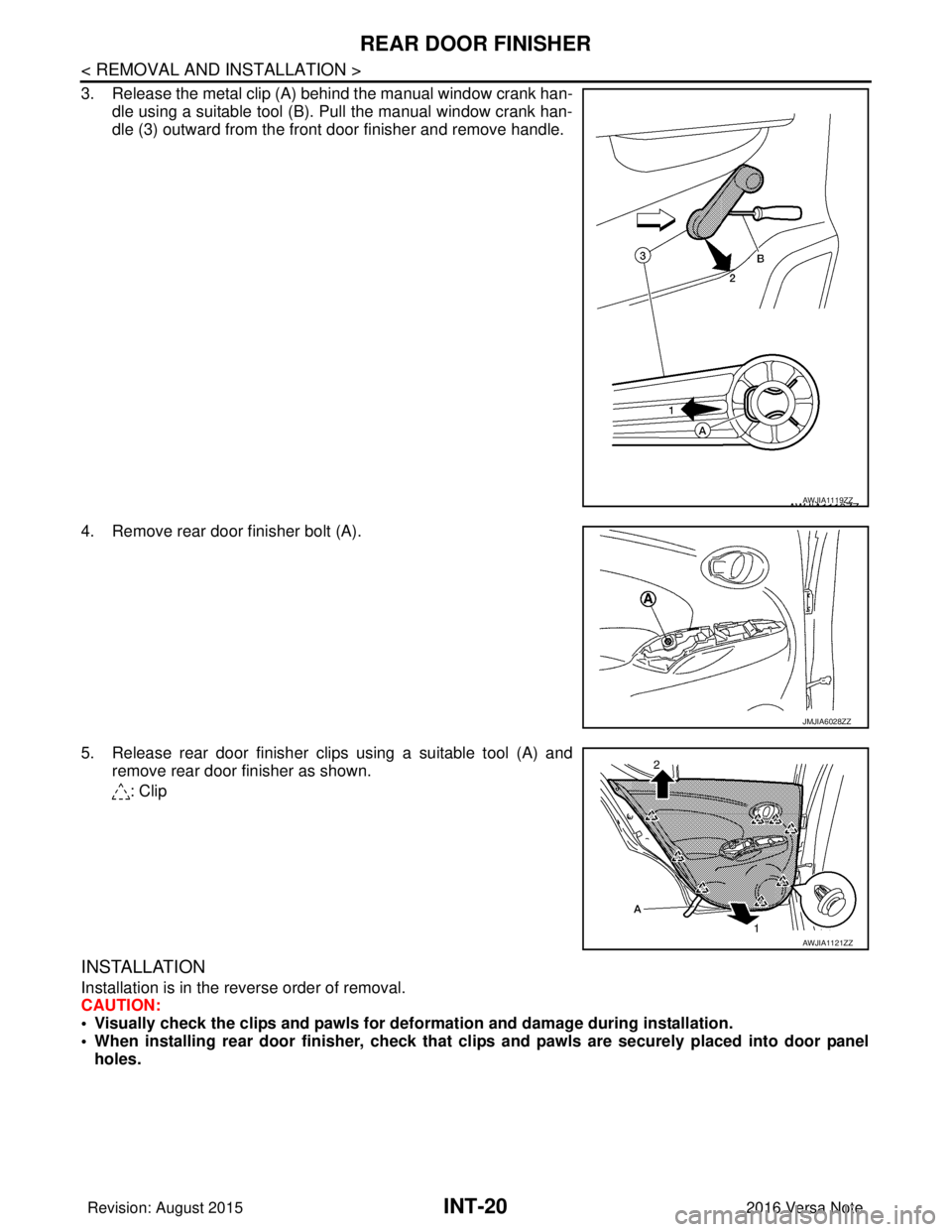
INT-20
< REMOVAL AND INSTALLATION >
REAR DOOR FINISHER
3. Release the metal clip (A) behind the manual window crank han-dle using a suitable tool (B). Pull the manual window crank han-
dle (3) outward from the front door finisher and remove handle.
4. Remove rear door finisher bolt (A).
5. Release rear door finisher clips using a suitable tool (A) and remove rear door finisher as shown.
: Clip
INSTALLATION
Installation is in the reverse order of removal.
CAUTION:
• Visually check the clips and pawls for deformation and damage during installation.
• When installing rear door finisher, check that clips and pawls are securely placed into door panel
holes.
AWJIA1119ZZ
JMJIA6028ZZ
AWJIA1121ZZ
Revision: August 2015 2016 Versa Note
cardiagn.com
Page 2173 of 3641
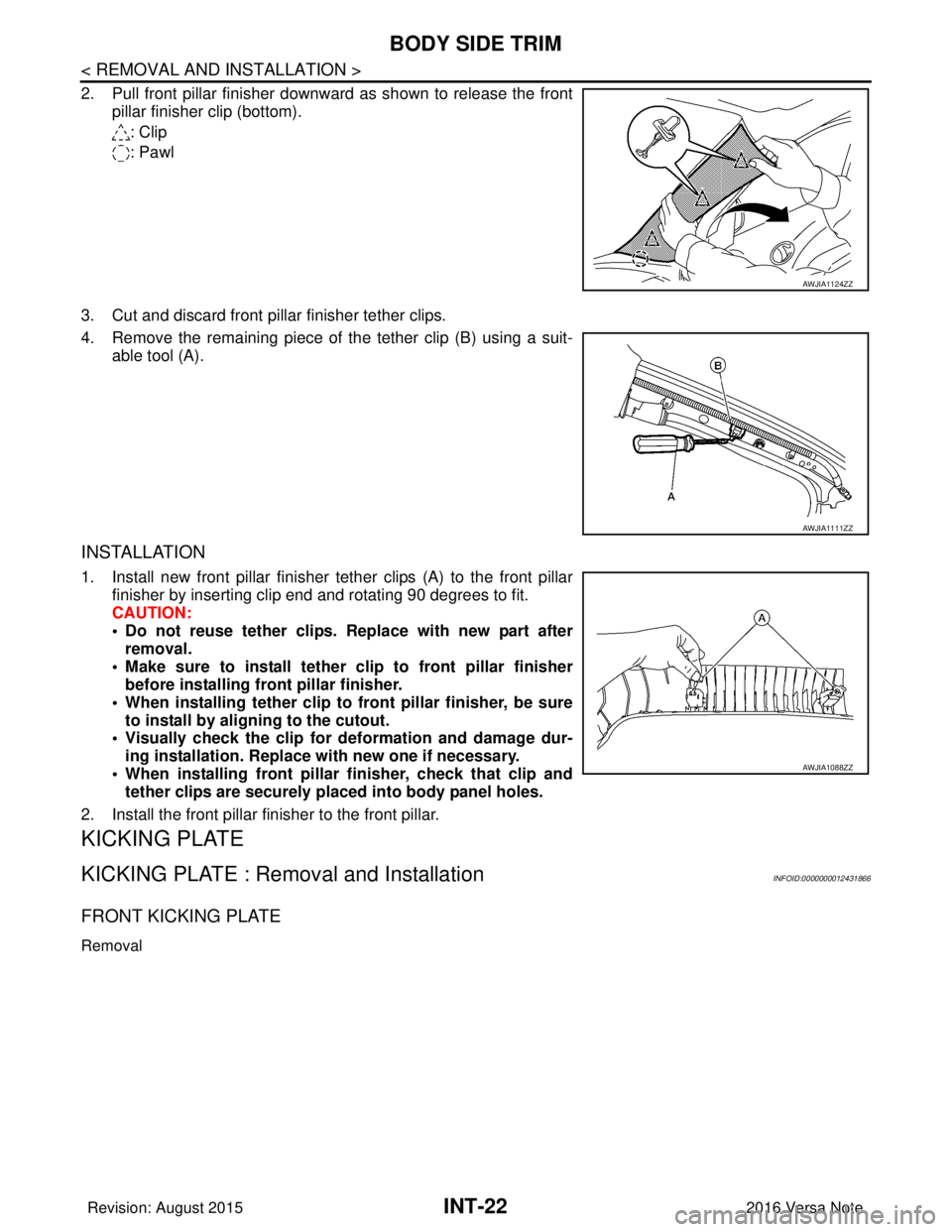
INT-22
< REMOVAL AND INSTALLATION >
BODY SIDE TRIM
2. Pull front pillar finisher downward as shown to release the frontpillar finisher clip (bottom).
: Clip
: Pawl
3. Cut and discard front pillar finisher tether clips.
4. Remove the remaining piece of the tether clip (B) using a suit- able tool (A).
INSTALLATION
1. Install new front pillar finisher tether clips (A) to the front pillarfinisher by inserting clip end and rotating 90 degrees to fit.
CAUTION:
• Do not reuse tether clips. Replace with new part after
removal.
• Make sure to install tether clip to front pillar finisher before installing front pillar finisher.
• When installing tether clip to front pillar finisher, be sure to install by aligning to the cutout.
• Visually check the clip for deformation and damage dur-
ing installation. Replace with new one if necessary.
• When installing front pillar finisher, check that clip and
tether clips are securely placed into body panel holes.
2. Install the front pillar finisher to the front pillar.
KICKING PLATE
KICKING PLATE : Removal and InstallationINFOID:0000000012431866
FRONT KICKING PLATE
Removal
AWJIA1124ZZ
AWJIA1111ZZ
AWJIA1088ZZ
Revision: August 2015 2016 Versa Note
cardiagn.com